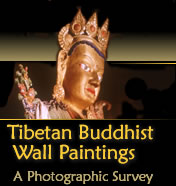








|
HISTORY 1 2 The ancient Himalayan hill state now generally known as Mustang was, historically, an independent kingdom within the sphere of influence of the western states of Tibet. Its original name was Lo, as it is still known to its people, the Loba, who speak a dialect of Tibetan. The main seat of its rajas, or kings, now its administrative center, is the town of Monthang (sometimes spelled Manthang), now often referred to as Lo Monthang. The name "Mustang" is a derivation of that word, apparently a Nepali or perhaps a British mispronunciation, unrelated to the name of a certain type of horse. Much of the geographic territory now recognized as Nepal formerly consisted of a number of small hill states and petty kingdoms, the state of Lo among them. Lo was the gateway to one of the easier pass routes to Tibet, and its kings grew rich collecting taxes on the trade of salt and wool from Tibet, and tea, rice, and other goods from what is now southern Nepal and from India. In the late eighteenth century, Lo fell to a neighboring state, but both were soon afterward annexed into Nepal when Prithvi Narayan Shah, king of one of the hill states, conquered the others and unified them to create the nation of Nepal. The Tibetan border is only a few miles from Lo Monthang. Safe on the Nepali side of the line, Mustang's art and culture remained unscathed during the ravages of the Chinese invasion and the Cultural Revolution. The wealth it gained from its control of the trade route between Tibet and the south enabled the royal house of Lo to commission the building and adornment of the two great gompas, Thubchen and Jampa. For this, master artists and craftsmen, many of them Newari, were brought to Lo. The Newaris, the indigenous people of the Kathmandu Valley, were highly trained and exceptionally gifted, famous for their skill in painting, carving, building, and metalwork, their handiwork broadly recognized and admired throughout a wide region. They achieved a status comparable to that of Florentine artists in renaissance Europe, although Himalayan artists (Newari, Tibetan, Kashmiri, and others) did not customarily sign their work but remained almost always anonymous. (One Newari artist and designer, however, achieved exceptional personal fame: Arniko [Aniko], who in the thirteenth century was brought to the court of Kublai Khan, then emperor of China, and placed in charge of the imperial craftsmen.) The artist was a medium rather than a creator, whose function was to transmit or reproduce, not invent, the correct representation of a deity. Only correct representation could serve as a passage for the true transmission of a spiritual essence. After Lo fell to the neighboring state of Jumla, it lost its control of the trade route and the revenue of its taxes. Mustang became poor and fell into obscurity, yet paradoxically, this may have saved its art treasures. Frequently and even customarily in the Tibetan cultural world, faded gompa murals in a state of deterioration were overpainted. Mustang's later poverty may have preserved the original wall paintings.
The first modern scholar to view the paintings of Thubchen and Jampa
was the great Tibetologist, Giuseppe Tucci, who was allowed to visit
Mustang in 1952. He wrote of his fear that, due to their deteriorating
condition, "in a few years only the ruins will remain of these
imposing buildings which belong to the best period of Tibetan art."
Their paintings, he wrote, According to Khenpo Tashi Tenzin Rinpoche, the abbot of Lo Monthang, Jampa gompa was built by King Amapal (A me dpal) and his son, A mgon tshe dbang bzang po, in accordance with instructions given by Ngorchen Kunga Zangpo.
Due to the kindness of the compassionate great Dharma king Text in Tibetan:
bka' drin pa chos rgyal chen po A mgon bzang po yab sras mams [Contents] [Introduction] [Jampa] [Thubchen] [Luri] [Site Index] [Home] Copyright © 2003 Philip and Marcia R. Lieberman |
